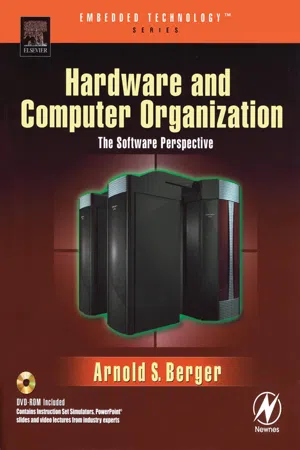
- 512 pages
- English
- PDF
- Available on iOS & Android
Hardware and Computer Organization
About This Book
Hardware and Computer Organization is a practical introduction to the architecture of modern microprocessors. This book from the bestselling author explains how PCs work and how to make them work for you. It is designed to take students "under the hood" of a PC and provide them with an understanding of the complex machine that has become such a pervasive part of everyday life. It clearly explains how hardware and software cooperatively interact to accomplish real-world tasks.
Unlike other textbooks on this topic, Dr. Berger's book takes the software developer's point-of-view. Instead of simply demonstrating how to design a computer's hardware, it provides an understanding of the total machine, highlighting strengths and weaknesses, explaining how to deal with memory and how to write efficient assembly code that interacts directly with, and takes best advantage of the underlying hardware. The book is divided into three major sections: Part 1 covers hardware and computer fundamentals, including logical gates and simple digital design. Elements of hardware development such as instruction set architecture, memory and I/O organization and analog to digital conversion are examined in detail, within the context of modern operating systems. Part 2 discusses the software at the lowest level¸ assembly language, while Part 3 introduces the reader to modern computer architectures and reflects on future trends in reconfigurable hardware.
This book is an ideal reference for ECE/software engineering students as well as embedded systems designers, professional engineers needing to understand the fundamentals of computer hardware, and hobbyists.
- The renowned author's many years in industry provide an excellent basis for the inclusion of extensive real-world references and insights
- Several modern processor architectures are covered, with examples taken from each, including Intel, Motorola, MIPS, and ARM
Frequently asked questions
Information
Table of contents
- Front Cover
- Hardware and Computer Organization: The Software Perspective
- Copyright Page
- Contents
- Preface
- Acknowledgments
- What's on the DVD-ROM?
- Chapter 1. Introduction and Overview of Hardware Architecture
- Chapter 2. Introduction to Digital Logic
- Chapter 3. Introduction to Asynchronous Logic
- Chapter 4. Introduction to Synchronous Logic
- Chapter 5. Introduction to State Machines
- Chapter 6. Bus Organization and Memory Design
- Chapter 7. Memory Organization and Assembly Language Programming
- Chapter 8. Programming in Assembly Language
- Chapter 9. Advanced Assembly Language Programming Concepts
- Chapter 10. The Intel x86 Architecture
- Chapter 11. The ARM Architecture
- Chapter 12. Interfacing with the Real World
- Chapter 13. Introduction to Modern Computer Architectures
- Chapter 14. Memory Revisited, Caches and Virtual Memory
- Chapter 15. Performance Issues in Computer Architecture
- Chapter 16. Future Trends and Reconfigurable Hardware
- APPENDIX A. Solutions for Odd-Numbered Exercises
- About the Author
- Index